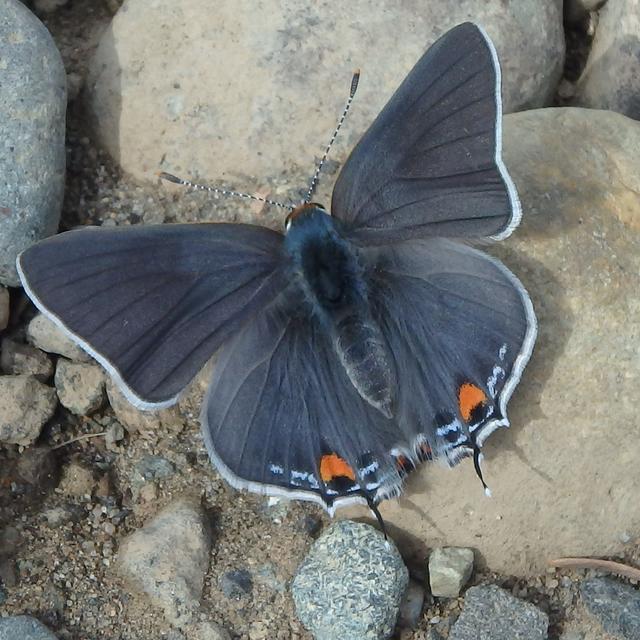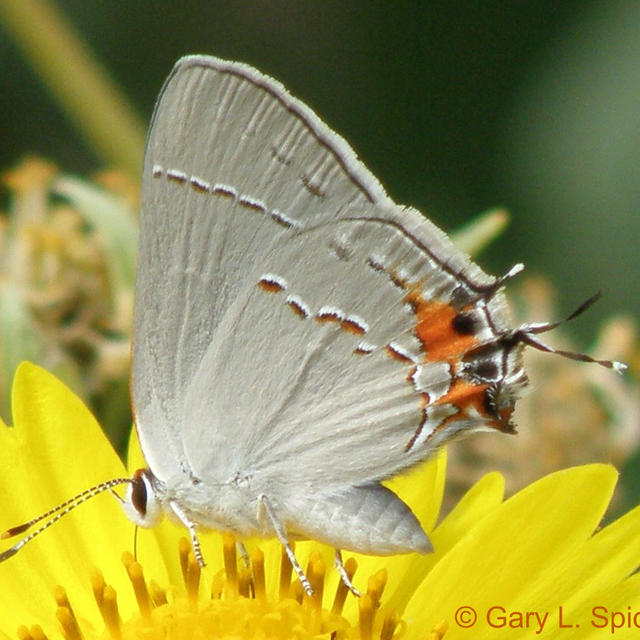Gray Hairstreak
Strymon melinus (Hübner, 1818)
Family: Lycaenidae
Subfamily: Theclinae
Identification: One tail on hindwing. Upperside blue-gray with large red spot near tail. Underside of spring/fall form is dark gray, summer form is paler gray. Relatively straight postmedian line is white, bordered with orange on the inside edge.
Wing Span: 7/8 - 1 3/8 inches (2.2 - 3.5 cm).
Life History: Males perch all afternoon on small trees and shrubs to seek receptive females. Eggs are laid singly on flowers of host plant. Young caterpillars feed on flowers and fruits; older ones may eat leaves. Chrysalids hibernate.
Flight: Two flights from May-September in the north, three-four flights from February-November in the south.
Caterpillar Hosts: Flowers and fruits from an almost endless variety of plants; most often from pea (Fabaceae) and mallow (Malvaceae) families including beans (Phaseolus), clovers (Trifolium), cotton (Gossypium), and mallow (Malva).
Adult Food: Nectar from many flower species including dogbane, milkweed, mint, winter cress, goldenrod, tick trefoil, and white sweet clover.
Habitat: Open, nonforested sites; common in disturbed, weedy areas.
Range: Throughout continental United States from southern Canada south to Mexico; southward to Venezuela. Comments: The most widespread hairstreak in North America.
Conservation: Not usually required.
NCGR: G5 - Demonstrably secure globally, though it may be quite rare in parts of its range, especially at the periphery.
Management Needs: Caterpillars may cause economic damage to bean and cotton crops.
Get your BAMONA Gear!
Please donate!
We depend on donations to keep Butterflies and Moths of North America freely available. We want to express our gratitude to all who showed their support by making a contribution this year. You can donate to support this project at any time.
Advertise with us!
Do you have a product or service that you think would interest BAMONA users? If you would like to advertise on this website, contact us by email, or use the contact form and select the "Advertising" category.
Verified Sightings
Displaying 1 - 24 of 7012 verified sightings

Observation date: Sep 27, 2023
Submitted by: jrtindall
Region: Mercer County, New Jersey, United States
Verified by: jwileyrains
Verified date: Nov 16, 2024

Observation date: Nov 11, 2024
Submitted by: James Steen
Region: Harper County, Kansas, United States
Verified by: James Steen
Verified date: Nov 11, 2024

Observation date: Oct 05, 2024
Submitted by: Chrustay
Region: Quay County, New Mexico, United States
Verified by: stevecary
Verified date: Nov 04, 2024

Observation date: Oct 27, 2024
Submitted by: Sheilabean
Region: Texas, Tarrant County, United States
Verified by: jwileyrains
Verified date: Nov 03, 2024

Observation date: Nov 01, 2024
Submitted by: jmgesell
Region: Northampton County, Pennsylvania, United States
Verified by: davidwright
Verified date: Nov 03, 2024

Observation date: Oct 15, 2024
Submitted by: Sheilabean
Region: Texas, Tarrant County, United States
Verified by: jwileyrains
Verified date: Oct 18, 2024

Observation date: Aug 29, 2024
Submitted by: MAKI
Region: Santa Catalina Island County, California, United States
Verified by: Ken Davenport
Verified date: Oct 17, 2024

Observation date: Oct 14, 2024
Submitted by: Sheilabean
Region: Texas, Tarrant County, United States
Verified by: jwileyrains
Verified date: Oct 15, 2024

Observation date: Oct 08, 2024
Submitted by: leighgodchaux
Region: Vermilion Parish, Louisiana, United States
Verified by: CA Ivy
Verified date: Oct 10, 2024

Observation date: Apr 30, 2024
Submitted by: hasfitz5
Region: Cochise County, Arizona, United States
Verified by: John Saba
Verified date: Oct 09, 2024

Observation date: Sep 20, 2024
Submitted by: bentert
Region: Pima County, Arizona, United States
Verified by: John Saba
Verified date: Oct 09, 2024

Observation date: Oct 03, 2024
Submitted by: jrmbutterfly
Region: Santa Cruz County, Arizona, United States
Verified by: John Saba
Verified date: Oct 09, 2024

Observation date: Sep 02, 2023
Submitted by: katb1
Region: British Columbia, Canada
Verified by: Paul Prappas
Verified date: Sep 24, 2024

Observation date: Sep 02, 2024
Submitted by: MinPinLord
Region: British Columbia, Canada
Verified by: Paul Prappas
Verified date: Sep 14, 2024

Observation date: Aug 25, 2024
Submitted by: jrmbutterfly
Region: British Columbia, Canada
Verified by: Paul Prappas
Verified date: Sep 11, 2024

Observation date: Sep 06, 2024
Submitted by: Christinalea
Region: Texas, Wichita County, United States
Verified by: jwileyrains
Verified date: Sep 06, 2024

Observation date: Sep 03, 2024
Submitted by: jmgesell
Region: Northampton County, Pennsylvania, United States
Verified by: davidwright
Verified date: Sep 05, 2024

Observation date: Sep 01, 2024
Submitted by: TJ in Derry
Region: Rockingham County, New Hampshire, United States
Verified by: John Calhoun
Verified date: Sep 01, 2024

Observation date: Aug 30, 2024
Submitted by: Kentonky41015
Region: Kenton County, Kentucky, United States
Verified by: CA Ivy
Verified date: Aug 31, 2024

Observation date: Aug 27, 2024
Submitted by: maryjanzen
Region: Centre County, Pennsylvania, United States
Verified by: davidwright
Verified date: Aug 29, 2024

Observation date: Aug 27, 2024
Submitted by: C²²H²⁸N²O
Region: Cameron County, Texas, United States
Verified by: jwileyrains
Verified date: Aug 28, 2024

Observation date: Aug 18, 2024
Submitted by: ButtahflyEtn37354
Region: Monroe County, Tennessee, United States
Verified by: James Steen
Verified date: Aug 22, 2024

Observation date: Aug 20, 2024
Submitted by: Zencoyote
Region: San Diego County, California, United States
Verified by: Ken Davenport
Verified date: Aug 22, 2024

Observation date: Aug 16, 2024
Submitted by: Blue Swallowtail
Region: Adams County, Nebraska, United States
Verified by: Emily Geest
Verified date: Aug 21, 2024
- 1 of 293
- next ›

















